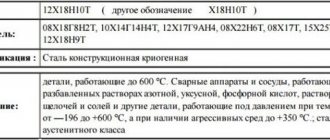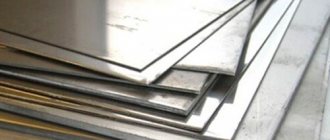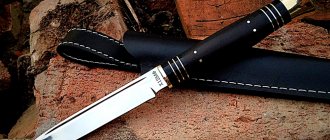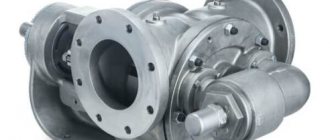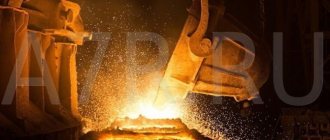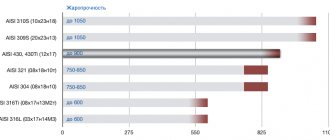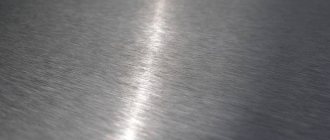Pros and cons for knives
Basically, all kinds of cutting products are made from this grade of steel. Both household and medical.
Advantages:
- High hardness, equal to 56-59 HRC.
- Resistant to bending and impact.
- Easy to process and sharpen.
- Has stainless properties.
- Low cost.
Flaws:
- Deforms during use, slightly.
- Increased abrasion rate.
Use of Chromium-Molybdenum
Chrome-molybdenum is the best material for impact sockets. However, these heads are usually made much thicker and heavier than chrome vanadium manual heads. Impact sockets are heat treated differently than chrome sockets.
Chrome Molybdenum Impact Socket
Chromium-molybdenum allows impact sockets to withstand the significant, higher force impacts encountered when using impact guns. Impact sockets cannot be as hard as chrome because they need to absorb sharp and powerful impacts.
In addition, an important property of this type of alloy is its ability to carburize the surface. The core material tends to retain its bulk properties, and the alloy is also an excellent material for use in the manufacture of gears, pistons, pins and crankshafts.
Chemical composition
Percentage of elements in the alloy:
| Chemical element | Name | Minimum content % | Maximum content % |
| Cr | Chromium | 0,8 | 1,1 |
| Mn | Manganese | 0,75 | 1 |
| C | Carbon | 0,38 | 0,43 |
| Si | Silicon | 0,15 | 0,3 |
| Mo | Molybdenum | 0,15 | 0,25 |
| S | Sulfur | 0,04 | |
| P | Phosphorus | 0,35 | |
| Fe | Iron | 97,27 |
Basic additives:
- Manganese. Increases the rigidity and strength of the material. Changes the texture of steel. It becomes stronger in comparison with other metals.
- Chromium. Increases the anti-corrosion properties of the alloy. Steel gains stainless properties in an aqueous environment. But an aggressive acidic environment destroys steel.
- Molybdenum. The additive is responsible for the strength of the material: fragility and fragility.
Decoding
The American steel marking AISI 4140 means that it is alloyed chrome-molybdenum steel. The number 41 indicates the steel group, 40 indicates the carbon content x 100.
AISI 4140.
Use of Chrome Vanadium
Finished chrome vanadium products are smooth, hard and quite shiny. Chrome vanadium finish probably comes to mind when most people hear the word chrome.
Chrome vanadium tool sockets are well suited for hand tightening and slow action applications such as ratchets. Chrome vanadium socket sets are known for their rigidity and hardness and also provide a high degree of rust protection.
Chrome vanadium is not ideal for impact sockets. Its rigidity can cause the anvil to wear out too quickly when using pneumatic impact wrenches.
In addition, chromium vanadium is used in high-speed steels. These tool steels are used as materials for cutting tools.
At the same time, chromium and vanadium make steel more hardenable. Another beneficial property is that chromium can keep steel resistant to abrasion, oxidation and corrosion. Another beneficial property is that chromium and carbon improve the elasticity of chrome vanadium.
Properties
Characteristics of steel behavior under various conditions and modes.
Mechanical
Mechanical properties show how much a material can withstand the influence of external loads. Basic properties are checked on samples when tested with various factors.
- Ultimate strength - the stress above which the material fails - 655 MPa.
- Yield strength - deformation of the material continues without changing stress - 415 MPa.
- Plasticity - helps, without changing the structure, to produce various shapes of products. The test sample is narrowed or expanded until a crack appears.
- Viscous properties indicate the ability to resist dynamic loads.
- The hardness of steel is the ability to resist the introduction of another material into a product.
- The tensile test shows figures in the range of 100-130 KSI.
Physical
Physical properties mean elasticity, density, thermal conductivity.
- The ratio of stress to deformation is the stability and elasticity of the product.
- Elastic modulus: E = 190-210 GPa.
- Density is the ratio of mass to unit volume: ρ = 7.7-8.1 kg/dm3.
- Poisson's ratio ν is in the range of 0.27-0.30, depending on the nature of the material.
- Shows elastic properties, value = transverse compression / longitudinal tension.
- Thermal conductivity shows the ability to conduct heat: k = 11.2-48.3 W/mK.
- Melting point - 1416 degrees C.
Technological
Technological properties show the material’s flexibility for various types of processing:
- Castability - in the molten state fills any mold.
- Malleability - processing by pressure without destruction. The material is deformed under press pressure or hammer blows.
- Weldability - suitability for making welded joints.
- Cutting removes excess parts of the product in the form of chips so that the workpiece acquires the desired appearance. This is the final processing stage.
Chrome-molybdenum steels
Joint alloying with chromium and molybdenum makes it possible to obtain steels that have higher wear resistance compared to chromium steels and lower cost compared to molybdenum steels.
Production technology, thermal, chemical-thermal treatment and properties of chromium-molybdenum sintered steels obtained by mechanical mixing of components have been studied in the works. Annealed carbonyl iron, colloidal graphite grade C-1, reduced chromium and molybdenum were used as the starting components. The compositions were prepared by mixing the powders for 20-30 hours in alcohol and 8 hours dry. The mixtures were pressed at a pressure of 780 MPa and sintered at a temperature of 1200 °C for two hours in a stream of dried hydrogen. After sintering, the steel had a residual porosity of 10-13%.
The structure of sintered steels is given in table. 17. With an increase in the concentration of carbide-forming elements, the structure becomes more heterogeneous, the spread in the microhardness of the steel base increases, and special carbides (Me23C6, Me7C3) are formed, the volume fraction of which increases. Residual austenite appears in amounts up to 50%.
The structure of chromium-molybdenum steel is more uniform compared to molybdenum and chromium steel. Multicomponent alloying, while reducing structural heterogeneity, does not completely eliminate it. Steels containing chromium and molybdenum in approximately equal quantities have the least heterogeneity of structure.
An increase in the sintering temperature and holding time, promoting an increase in the diffusion mobility of atoms and intensifying the processes of dissolution of chromium and molybdenum in the iron base, leads to both an increase in the saturation of the solid solution with alloying elements, as evidenced by an increase in the amount of retained austenite (Fig. 14), and to a decrease degree of inhomogeneity of the solid solution.
A study of the effect of cooling rate on the structure of steels sintered at 1200 °C for 2 hours showed that the cooling rate has the same effect as in the case of cast steels, i.e. The more alloyed the steel, the less influence the cooling rate has on the formation of the structure.
Thus, the structure of sintered steel ZhGr1Kh2M2, cooled at a rate of 0.05 K/s, is dispersed pearlite. Increasing the cooling rate to 0.5 K/s leads to the formation of sorbitol. An increase in the cooling rate from 0.05 to 0.5 K/s for high-alloy steels ZhGr1Kh5M5, ZhGr1Kh12M2 and ZhGr1Kh5M10 does not significantly change the nature of the emerging structure.
To increase the homogeneity of the structure, the sintered steels were subjected to carburization in a solid carburizer at a temperature of 920 °C for three hours, followed by quenching in oil and low tempering. The antifriction properties of chromium-molybdenum steels in the sintered state and after chemical-thermal treatment are characterized by the following data (in the numerator - in the sintered state, in the denominator - after chemical-thermal treatment):
The beneficial effect of chemical-thermal treatment on antifriction properties is explained by both a significant increase in steel hardness and a decrease in structure heterogeneity. If in sintered steel the structure is a set of components such as martensite, troostomartensite, retained austenite and carbides with sizes from 2 to 30 microns in an amount of 5-10% (volume), then steel subjected to chemical-thermal treatment has martensitic structure in which special carbides are evenly distributed, the share of which increases to 45% (volume). It is known that small, evenly distributed carbides, protruding above the friction surface, absorb the load, cut off the setting bridges and thereby improve the antifriction properties. In addition, the absence of retained austenite, which promotes setting, also leads to improved antifriction properties.
Comparative tests in kerosene of the wear resistance of heat-treated steel ZhGr1Kh12M2 and cast cemented steel 20Kh3MVF paired with cast hardened steel X12M, carried out on a modernized MI-1M friction machine at a load of 10 MPa and a sliding speed of 5 m/s for 10 s according to the roller-cylinder scheme with spherical head, showed that steel ZhGr1Kh12M2 has wear resistance higher than cast steel 20Kh3MVF:
At the same time, the wear of a roller made of cast steel Kh12M is also less when it is operated in tandem with sintered steel ZhGr1Kh12M2, which indicates higher antifriction properties of the ZhGr1Kh12M2-Kh12M pair compared to the friction pair 20Kh3MVF-Kh12M.
Another way to obtain chromium-molybdenum steels with a high degree of solid solution homogeneity is carburization of a pre-sintered carbon-free composition alloyed with chromium and molybdenum, for which the authors used the ZH12M2 composition. The absence of graphite in the initial charge has a favorable effect on the formation of a solid solution, since in this case, unlike a graphite-containing charge, the formation of carbides does not occur, binding alloying elements and preventing their diffusion into the solid solution.
Sintering of compacts of the ZHKh12M2 composition was carried out at a temperature of 1200 °C for two hours, which ensured the formation of a homogeneous solid solution. Sintered samples with a diameter of 25 and a height of 15 mm were subjected to carburization in a solid carburizer at a temperature of 920 °C for a duration of 1 to 9 hours. On the cemented samples, the distribution of carbon along the depth of the carburized layer was studied using the method of layer-by-layer chemical analysis, and the type and volume fraction of the carbide phase was determined.
It has been established that as a result of carburization within an hour, carbides of the cementite type Me3C are formed. With increasing carburization time, along with cementite-type carbides, more complex special carbides of the Me23C6, Me2C type are formed. An increase in the porosity of samples cemented for 5 hours also leads to the formation of complex Me23C6 carbides. This is probably due to the redistribution of carbon and alloying elements due to the activation of the diffusion mobility of atoms. The type of carbides depending on porosity and carburization time is presented in Table. 18.
In Fig. Figure 15 shows the dependence of carbon content on carburization time and distance from the surface of the sample. As can be seen from Fig. 15, as one moves deeper into the sample from the surface, the carbon content gradually decreases. If we take the layer containing 0.4% C as the thickness of the carburized layer, then after five hours of exposure the layer thickness was 1.6 mm. Longer carburization leads to through carburization of the samples.
The volume fraction of carbides in the surface layer of samples cemented for five hours increases sharply as porosity increases to 20% (Fig. 16). A further increase in porosity does not lead to a significant change in the volume fraction of the carbide phase, since the solid solution is saturated with carbon.
The structure of the carburized layer after quenching at a temperature of 900 °C is martensite with uniformly distributed dispersed carbides with an average size of 1 μm. The amount of carbon in the carburized layer is 0.7%, while the martensite of hardened steel ZhGr1Kh12M2, into the initial charge of which carbon was introduced in the form of graphite, contains only 0.28% C. Carburized steel ZhGr12M2 has a high degree of homogeneity of the solid solution with respect to chromium and molybdenum.
It has been established that with a porosity of 10%, the best combination of strength, toughness and hardness of ZHKh12M2 steel, obtained by carburizing a pre-sintered alloy base at 920 °C for five hours, is achieved as a result of quenching from a hydrogen atmosphere in oil and tempering at 180 °C.
Comparative studies of the mechanical properties and wear resistance of carburized steel ZHKh12M2 and steel ZHGr1Kh12M2, processed according to optimal conditions, showed that carburized steel after quenching and tempering at 180 °C has a higher complex of mechanical properties and wear resistance (Table 19). Wear resistance tests were carried out on a 77MT machine on samples in the form of plates at a load of 18 MPa. The samples were tested in tandem with hardened steel X12M.
The work studied the effect of heat treatment on the properties of chromium-molybdenum steels obtained using the technology described in the work. The properties of steels after sintering and hardening are given in Table. 20. Steels ZhGr1Kh2, ZhGr1M2, ZhGr1Kh2M2 were quenched in water, the rest - in oil.
The heterogeneity of the solid solution, characteristic of chromium-molybdenum steels, is the reason that certain areas of austenite, depleted in carbon and alloying elements, have reduced resistance to overcooling, and even during the hardening process, diffusion decomposition of austenite occurs in them, as a result of which, along with martensite in the structure of hardened steels contain troostite and sorbitol. With an increase in the amount of alloying elements in steel, the heterogeneity of austenite increases and the structure of steels becomes more heterogeneous. At the same time, the amount of primary sparingly soluble special carbides, the formation of which consumes carbon, increases, as a result, its content in martensite decreases.
The formation of a heterogeneous structure and low-carbon martensite leads to a decrease in the hardness of hardened steels. In conditions of high structural heterogeneity, when areas that sharply differ from each other in strength or plastic properties border each other, stress concentrators arise. During mechanical testing, the high strength of the metal base does not have time to be realized. This leads to the fact that tensile strength and impact strength are reduced due to the advanced action of brittle fracture concentrators. During the tempering process, due to the decomposition of martensite, the proportion of the brittle component decreases, and the steel acquires a more viscous and plastic sorbitol structure. The stressed state of steel is replaced by a more equilibrium one. The notching effect of stress concentrators decreases, and the strength of the metal base increases as the tempering temperature increases. As can be seen from Fig. 17a, the maximum strength of steel is acquired after quenching and tempering at a temperature of 400-500 °C. Moreover, this strength is higher than that which the steel had in the sintered state. At higher tempering temperatures, the dispersion of sorbitol decreases, which leads to a decrease in strength. As the tempering temperature increases, as follows from Fig. 17, b, c, hardness monotonically decreases, and impact strength increases.
The effect of alloying on fracture toughness was studied in the work. The fracture resistance of steels was studied on samples with a sharp notch and a fatigue crack. The samples were tested for static bending according to a three-point scheme at 20 °C with recording of fracture diagrams in load-deflection coordinates. Based on the results of bending tests, the critical stress intensity factor was calculated as a criterion for fracture toughness using the formula: where Рс is the fracture load; L - half the distance between supports; B, W are the thickness and width of the sample, respectively; a is the total length of the concentrator (notch and crack).
It follows from the results obtained (Fig. 18) that alloying powder steels allows one to simultaneously increase the characteristics of strength and fracture toughness. This is very important, since in practice, in order to increase the fracture toughness of a material, they often deliberately reduce its strength.
The authors of the works recommend using alloying with less concentrated additives than metal powders to obtain powder alloy steels with a homogeneous structure.
Using the example of steel ZhGr1Kh5M5, the work shows the possibility of producing powdered high-alloy steels with a uniform structure and a homogeneous solid solution by introducing chromium and molybdenum into the steel not in the form of pure powders, but in the form of chromium carbides (Cr3C2) and molybdenum (Mo2C). Using model samples consisting of 20% Fe and 80% carbides, it was established by x-ray diffraction that carbide (Fe, Mo, Cr)7C3 is formed during sintering:
During the sintering process, intensive replacement of chromium and molybdenum atoms in the carbide with iron atoms occurs and, consequently, dissolution of the carbide and saturation of the matrix with carbon, chromium and molybdenum.
The dissolution of complex carbide (Fe, Cr, Mo)7C3 occurs more intensively than, for example, pure carbide Mo2C, as a result of which a martensitic-austenitic structure is formed in the composition ZhСr3СМо2С5, while the structure of the composition ZhMo2C10 is ferrite with inclusions of carbides. The more intense dissolution of complex chromium-molybdenum carbide compared to molybdenum carbide is explained by the different influence of molybdenum and chromium on the narrowing of the y-region.
Molybdenum during the sintering process, narrowing the y-region, even at a concentration of 6 - 7%, complicates the conditions for the dissolution and diffusion of carbon in the iron base, as a result of which the iron matrix is practically carbon-free. The joint diffusion of chromium and molybdenum from the complex carbide into the iron base lowers the temperature of the a -> y-transformation and stabilizes the y-phase up to solidus temperatures, i.e. significantly expands the y-region and promotes more intense dissolution of complex chromium-molybdenum carbide. In the case when the diffusion of chromium and molybdenum occurs from carbides randomly distributed in the matrix, some structural heterogeneity occurs. Diffusion of chromium and molybdenum from one source - complex chromium-molybdenum carbide, the formation of which is possible through the interaction of Cr3C2 and Mo2C, leads to the formation of a homogeneous solid solution. According to the work, intensive dissolution of Cr3C2 and Mo2C carbides in iron is facilitated by their interaction during homogenizing annealing in the temperature range 600 - 1200 °C. Apparently, this interaction consists of mutual diffusion of metal components. It is known that chromium has a destabilizing effect on the octahedral coordination of atoms in Me6C carbide, while Mo increases the free energy of the trigonal-prismatic packing characteristic of chromium carbides. Such mutual influence, obviously, could also lead to intensive dissolution of Cr3C and Mo3C carbides in iron with the formation of a homogeneous solid solution.
The work investigated the phenomenon of solubility of chromium and molybdenum carbides in iron during sintering of Fe-Cr3C2, Fe-Mo C and Fe-Cr3C2-Mo2C compositions. The compositions were prepared on the basis of carbonyl iron grade 13-2 in order to eliminate technological factors as much as possible (large particle size, non-metallic inclusions, oxide films on powder particles, etc.).
Microstructural studies showed that at a temperature of 1150-1200 °C the structure of most of the studied Fe-Cr3C2-Mo3C alloys did not contain carbide particles and was either homogeneous austenite or its decomposition products. Micro-X-ray spectral analysis showed a high uniformity of the distribution of alloying elements over microvolumes of the solid solution. Thus, multicomponent alloying with carbides Cr3C2 and Mo2C led to their intensive dissolution in the iron matrix during sintering and subsequent homogenization of the solid solution.
Intensive dissolution of Cr3C2 and Mo3C carbides in the matrix during sintering with the entry of the entire amount of alloying elements and carbon into the solid solution continued up to 20% of their total amount in the charge, which indicated the existence of a y-region of solid solutions in this system up to 9.5% Mo , 9% Cr, 1.8% C.
Based on the data obtained, in Fig. Figure 19 shows the y-region of solid solutions in the system under study. For comparison, the same figure shows the region of the Fe-Cr-Mo-C system according to the work. It is clear that the obtained results of phase analysis do not agree with previously known ones: starting from compositions containing 0.6% C, the alloys of the Fe-Cr3C2-Mo2C system under study should, according to the data, be in the two-phase region y + Me6C. The maximum content of alloying elements and carbon in single-phase austenite of the system is 10.5% Cr; 5% Mo; 0.4% C, 1150-1200 °C, which is significantly lower than what was achieved in Fe-Cr3C2-Mo2C compositions. Consequently, single-phase austenite with a composition of 9.5% Mo; 9% Cr; 1.8% C was obtained in metallurgical practice for the first time. The reason for the discrepancy, apparently, is the nonequilibrium nature of the alloys studied in the cited work, in which one or another phase state was obtained by melting the sample, followed by cooling, heating to a temperature of 1150-1200 ° C and isothermal exposure. When a melt containing carbide-forming elements (Cr, Mo) and carbon is cooled, a roughly heterogeneous dendritic structure is formed, consisting of primary liquation dendrites and a matrix containing secondary carbides released during the cooling process from supersaturated areas of the solid solution. Heating to diffusion annealing temperatures and subsequent isothermal exposure led to the dissolution of secondary carbides, but were apparently ineffective for diffusion homogenization of the structure containing primary carbides.
The work used dispersed powders of chromium and molybdenum carbides, as well as iron. The general increase in the degree of dispersion of the system contributed to the intensification of the process of interaction and diffusion homogenization. In addition, the Cr3C2 and Mo3C powders used were characterized by a nonequilibrium defect structure, which intensified the interaction and subsequent diffusion homogenization.
This work examines the transformation characteristics and mechanical properties of chromium-molybdenum powder steels produced by various methods of introducing molybdenum. To prepare the samples under study, the following powders were used: atomized iron powder, alloyed powder (Fe-1%Cr-0.2%Mo) obtained by atomization, chromium carbide powder Cr3C2, molybdenum carbide powder Mo2C and natural graphite powder. To study the influence of the method of introducing molybdenum on the nature of transformations in steel and on its mechanical properties, various options for preparing mixtures were used (Table 21). Pre-doped powder was used in the CM-A mixture. CM-M and CM-C mixtures were prepared by adding molybdenum powder and molybdenum carbide powder, respectively. Samples pressed at a pressure of 588-608 MPa were sintered in vacuum (10 Pa) at a temperature of 1200 °C for one hour.
Cooling curves were constructed using the dilatometric method. The samples were heated at 880 °C for one hour and then cooled at different rates. The starting and ending points of the transformation were determined from dilatometric curves.
The sintered samples intended for fatigue and tensile testing were preliminarily prepared. austenitized at 850 C for 0.5 hours in vacuum and cooled at a speed of 0.06; 2.5 and 12.7 K/s.
In Fig. Figure 20 shows the thermokinetic curves of the studied samples. Regions F, P, B and M in the diagrams correspond to areas where ferrite, pearlite, bainite and martensite are formed, respectively. It can be seen from the figure that the cooling curves of the SM-M sample obtained by adding molybdenum powder are significantly shifted to the left compared to the curves of the SM-A sample obtained from a preliminary alloyed powder. The shape of the curves does not change. In the cooling curves of sample SM-S, obtained by adding molybdenum carbide powder, the area of bainite formation is wider than that of sample SM-M. Microstructural studies have shown that all obtained samples are characterized by structural heterogeneity, which can be divided into three zones: a segregation zone, a diffusion zone, and a non-diffused zone. In the SM-S sample prepared with the addition of molybdenum carbide powder, the boundary between the diffusion zone and the segregation zone is blurred and indistinct, while in the SM-M sample prepared by adding molybdenum powder, the boundary between the diffusion zone and the segregation zone is much narrower and clearer.
According to X-ray microanalysis, in the CM-M sample the molybdenum concentration is 4-5% in the immediate vicinity of the core of the segregation zone, 1.0-1.2% in martensite zones and 0.4% in bainite zones. At the same time, in sample CM-C the maximum concentration of molybdenum in the center of the segregation zone is 0.6-0.8%. In addition, in sample CM-C, the difference in molybdenum concentration between the areas surrounding the segregation zone on one side and the diffusion zone on the other is difficult to determine. These results indicate that the diffusion zone in the CM-C sample is more elongated compared to that in the SM-M sample. This is what causes the expansion of the bainite zone on the thermokinetic diagram of the SM-S sample.
The microstructure of mechanical test specimens depends on the cooling rate. After cooling at a rate of 0.06 K/s, samples CM-A, CM-M and CM-C have a ferrite-pearlite structure. Cooling at a rate of 2.5 K/s leads to the formation in the CM-A sample of a predominantly bainitic structure with areas of ferrite and pearlite. In samples CM-M and CM-C, a heterogeneous structure consisting of ferrite, pearlite, bainite and martensite is formed. When cooled at a rate of 12.7 K/s, sample CM-A has a uniformly distributed bainitic and martensitic structure, while samples CM-M and CM-C retain a heterogeneous structure, including ferrite, pearlite, bainite and martensite.
Mechanical testing has shown that tensile strength increases as cooling rate increases and elongation decreases in all materials tested. At a cooling rate of 2.5 K/s, the tensile strength of the pre-alloyed powder material is superior to the tensile strength of the mixed powder materials. This difference is explained by the microstructure of the samples. The microstructure of the powder mixture samples is primarily ferrite-pearlite, while the microstructure of the prealloyed powder material is primarily bainite. The mechanical properties of samples made from powder mixtures differ little from each other.
Fatigue strength increases with increasing tensile strength, regardless of the method of molybdenum addition. However, steels made by adding molybdenum carbide have higher fatigue strength. Fractographic analysis showed that in steels with the addition of molybdenum carbide, dispersed martensite crystals in a heterogeneous structure serve as an obstacle to the propagation of fatigue cracks.
The work investigated the dependence of the strength of powdered chromium-molybdenum steel on the method of introducing alloying additives and the conditions for carrying out HTMT.
Alloying additives were introduced by the following methods: mixing with iron powder, dispersion, and joint reduction of oxides using the calcium hydride method. Iron powder of the PZhCh grade was used as the starting materials for mixing and dispersing, chromium was introduced in the form of a powder of the high-alloy PKh30 alloy, and molybdenum was introduced in the form of a powder of the MPC grade. Steel grade PKh13M2 was obtained by the calcium hydride method. Mixing of powders was carried out in a mixer with a displaced axis of rotation. The grinding time of the powders in a ball mill was 72 hours. The powders obtained by various methods were pressed and sintered in an atmosphere of dissociated ammonia at a temperature of 1300 °C. High-temperature thermomechanical processing of sintered workpieces was carried out by extrusion at a temperature of 1000 °C with quenching in water and oil. The degree of compression during deformation varied within 30-70%. The study was carried out using the method of mathematical experimental planning.
As a result of the study, it was found that the quenching medium has virtually no effect on the strength properties of the material. Maximum hardening of powdered chromium-molybdenum steel is achieved by using dispersion of the original powders. Deformation affects differently with different methods of obtaining the material.
Increasing the degree of deformation of samples produced by both mixing and dispersing significantly increases the strength of the sintered material. As for samples made from powder obtained by the calcium hydride method, an increase in the degree of deformation causes a slight increase in their tensile strength.
Deformation of the samples obtained from the dispersed charge with a degree of compression of 80% made it possible to obtain a value of ov = 1500-1550 MPa.
The work studied the production technology and properties of chromium-molybdenum steels additionally alloyed with silicon. The composition of the studied steels is presented in table. 22.
The mixtures were prepared on the basis of carbonyl iron powder with the addition of reduced chromium and molybdenum and silicon powders. The mixtures pressed at 800 MPa were sintered at temperatures of 1050-1250 °C with an interval of 50 degrees for two hours in a stream of dried hydrogen. The cooling rate from the sintering temperature was 0.25-0.28 °C/s.
A study of the structure of sintered chromium-molybdenum silicon steels showed that silicon, which has a diffusion coefficient many times lower than carbon, is much less soluble in the iron base. At a temperature of 1050-1150 °C, large (more than 10 microns) undissolved silicon particles are found in the steel structure. In place of the dissolved particles, areas of silicon ferrite with a microhardness of 240-260 HV and areas with a high silicon content (up to 70-80%) appear, bordered by dark contours, the appearance of which is explained by the fact that the diffusion processes occurring during sintering do not completely restore the contact between iron and silicon particles, disrupted as a result of a decrease in the volume of the dissolving silicon particle. Iron atoms arriving by self-diffusion, dispersing over the entire surface of the cavity and trying to occupy positions with the least amount of energy, fill mainly micropores and cracks, and not protruding areas that could become contact. Areas with increased silicon concentrations are also found at higher temperatures (1200-1250 °C), which indicates that large silicon particles, having dissolved in the iron base under the selected sintering modes and isothermal holding conditions, do not have time to diffuse throughout the volume.
The presence of high-silicon regions of silicon ferrite and especially undissolved silicon crystals increases the heterogeneity of the structure, reduces the mechanical properties and creates unequal conditions for the graphitization process. Before graphitization, the sintered steels were carburized for three hours, followed by oil quenching. Graphitizing annealing was carried out at temperatures of 750 and 850 °C, i.e., in the region of critical temperatures (point Ac for the alloys under study, as dilatometric studies have shown, lies in the region of 780-830 °C) and at a temperature of 1100 °C, i.e. above the Acm line. The holding time at all temperatures was 2 hours, cooling from temperatures below Ac1 was carried out together with the furnace, from temperatures above Acm to a temperature of 600 °C at a rate of 60 °C/h, and below - together with the furnace.
Metallographic studies showed that the largest amount of graphite was released during annealing at temperatures above the Acm point, somewhat less at a temperature of 750 °C and very little at 850 °C. Some free carbon is found in case-hardened steels. Both in the process of carburization and in the process of additional annealing, finely dispersed point and lamellar graphite is released.
Thus, despite the presence of carbide-forming elements (chromium and molybdenum), graphitization in sintered steels proceeds intensively. Obviously, an important role is played by various types of defects characteristic of powder steels.
The microstructure of the base of graphitized steels depends on both the cooling rate and the chemical composition, differing from sintered steels by a greater degree of homogenization due to additional heating, which plays the role of homogenizing annealing. A distinctive feature of the structure of graphitized steels is a large number of small, uniformly distributed carbides in the surface layer, formed due to the diffusion of carbon from the backfill during graphitizing annealing.
The antifriction properties of steels in the sintered state and after additional carburization at a temperature of 920 °C for three hours, followed by quenching in oil with low tempering are given in Table. 23.
Cast hardened steel of carbide class X12M was used as a counterbody. The tests were carried out using TS-1 aviation fuel. From the table, it can be seen that the antifriction properties of sintered and heat-treated steels when tested in oil differ very little, since spindle oil promotes the formation of boundary lubricating films that protect contact surfaces from direct contact during friction. The properties of the material itself play a secondary role here. At loads of 8.8-9.8 MPa, the boundary oil film breaks through, resulting in setting. The influence of chemical-thermal treatment is more pronounced when testing materials in TS-1 aviation fuel, since the aggressive action of non-polar hydrocarbons C10H22, which are part of this fuel and are not capable of stable orientation on the metal surface, leads to the seizure of rubbing surfaces. Thus, when tested in TC-1 fuel, the main influence on the antifriction characteristics should be exerted by the properties and structure of the material itself.
The antifriction properties of steels subjected to various modes of graphitizing annealing were tested on an MI-1M machine in TC-1 fuel with dissolved water at a temperature of 70 C paired with cast hardened steel of the X12M carbide class. The antifriction properties of graphitized steels when tested in TC-1 fuel are presented in Table. 24.
The best antifriction properties have steels annealed at 1000 and 750 C, i.e. having in their structure finely dispersed point and lamellar annealed graphite.
The wear resistance of friction pairs was tested in a device simulating the operation of fuel control equipment of an aircraft engine. The steel used for testing was ZhGr1Kh5M10S2.5, which has the best antifriction properties after graphitization. Samples were made from this steel, shaped like thrust bearings used in friction units of fuel control equipment. The bearings were tested both in the sintered state and after carburization and additional graphitizing annealing. The counterbody was a plunger made of X12 steel, having a hardness of 62-65 HRC (Fig. 21).
Bench tests in the device were carried out in the following modes: speed 63.5 s-1; pressure 9.8 MPa; the angle of inclination of the thrust bearing is 14 degrees; test time 30 hours; lubricant - aviation fuel TC-1 with dissolved water; fuel temperature 40 °C.
The total linear wear of the thrust bearing-plunger pair, as well as the wear of the thrust bearing, is shown in Fig. 22. For comparison, the test results of thrust bearings made of cemented steel 20Kh3MVF, having a hardness of 62-65 HRCe, are presented. The wear of thrust bearings made of sintered steel ZhGr0.8Kh5M10S2.5 is almost 1.5 times higher than that of bearings made of 20KhZMVF steel. Cementation of ZhGr0.8Kh5M10S2.5 steel increased wear resistance three times compared to sintered steel and almost 2.5 times compared to 20KhZMVF steel. The wear of the thrust bearing and plunger is uniform. In the case of testing graphitized bearings, the wear pattern is somewhat different. The thrust bearing, almost without wearing itself out, greatly wears out the counterbody. This is due to the fact that during the graphitizing annealing process, along with the appearance of free graphite, the amount of carbides greatly increases, which wear out X12M steel. The surface of the thrust bearings and plungers was good in all cases after testing.
Recommendations for processing
Aisi 4140.
Processing features improve and consolidate the desired properties.
- To increase the cutting force, the surface is hardened and hardened.
- Turning operations are carried out during longitudinal turning, processing of ends and profiles.
- Welding processing is done without preliminary heat treatment and heating.
Application of X50CrMoV15 steel
X50CrMoV15 steel is used in industries with increased hygienic requirements. It is used for the manufacture of medical equipment and in the pharmaceutical industry. It is also used in the food and processing industries.
From all this it follows that the alloy is perfect for making knives. The optimal percentage of alloying substances provides the metal with high corrosion resistance. And also excellent mechanical strength and durability of the cutting edge.
Knives made from this steel have been shown in tests; in some areas, the parameters are better than those of their analogues. Alloy Products:
- holds an edge well;
- do not change their color;
- less susceptible to oxidation;
- ideal for intensive use;
- have a perfect appearance.
Steel grade 38ХА
38XA chromium steel contains 0.38% carbon and less than 1.5% chromium. The total amount of alloying elements is less than 2%, so it belongs to the category of low-alloy steels. Along with this, the steel is high quality (the letter “A” is present in the marking).
Among the distinctive features of grade 38ХА are the tendency to temper brittleness and flake sensitivity. When hardening it, oil and exposure to high temperatures are used. After hardening, tempering is used at 550°C followed by cooling in water. Grade 38ХА is used in the manufacture of gears, bolts, worms and other structural products.
Steel grade 35ХМА
Chrome-molybdenum steel grade 35ХМА is high-quality, as indicated by the letter “A” at the end of the marking. Alloying elements in the composition are less than 3%, so it is low-alloyed. Like its predecessor, grade 35ХМА is subjected to hardening at high temperatures and subsequent tempering.
Steel grade 35ХМА has found wide application in shipbuilding, mechanical engineering and aircraft manufacturing. It is used for the manufacture of parts that operate under heavy loads. This steel can be useful in making pipe fittings, gears, studs, flanges and many others. Also, grade 35ХМА is used in the manufacture of instruments and parts used in the oil and gas industry.
Screwdriver design
The main parts of a screwdriver are the shaft and the handle. In turn, the rod has a working area - a tip with a slot, and the handle consists of a base material, an additional layer or lining and options, such as a hole and a hammer head.
All these parts and materials together affect the quality of the screwdriver, its performance and durability.
Molybdenum steel characteristics
Due to its properties, the use of molybdenum in industry is widespread in Russia and the world. Metallurgy, aviation industry, mechanical engineering, agriculture - this is not the whole list where this strategic metal is used. It is in such demand that the price of molybdenum is steadily increasing from year to year.
Refractory metal molybdenum
| Rolled metal calculator [td]Molybdenum belongs to the class of refractory metals, which makes its use unique in areas associated with high temperatures. The page provides a description of this metal: physical, chemical properties, areas of application, brands, types of products. |
Molybdenum (Mo) (Molybdenum) is a chemical element with atomic number 42 in the periodic table, a malleable transition metal of a steel-gray color when compacted and black-gray when dispersed.
Density 10.2 g/cm3, melting point. = 2620°C, boiling point = 4630°C. in the earth's crust 3·10-4% by mass. Molybdenum is not found in free form. About 20 minerals are known.
The most important of them are: molybdenite MoS2, powellite CaMoO4, molybdite Fe(MoO4)3 nH2O and wulfenite PbMoO4.
Molybdenum was discovered in 1778 by the Swedish chemist Carl Scheele - the oxide MoO3 was obtained. In 1782, P. Ghelm first obtained Mo in the metallic state, but contaminated with carbon and molybdenum carbide. Pure metal was obtained in 1817 by the Swedish chemist J. Berzelius.
The first attempts to use molybdenum in steel metallurgy date back to the end of the last century. Its industrial production began in 1909-1910.
, when the special properties of gun and armor steels alloyed with this metal were discovered, and a technology for producing compact refractory metals using powder metallurgy was developed.
Share: Facebook
- Previous entryMarking of food grade stainless steel
- Next entryClassification of steels by degree of deoxidation
No comments yet
Screwdriver tip
The main working part of a screwdriver is its tip. It is also sometimes called “sting”. To ensure that the tool lasts a long time and does not cause trouble, when choosing a screwdriver, take a closer look at the tip.
Processing quality
First of all, you should visually examine the quality of metal processing on the tip. Edges and surfaces must be carefully milled and sanded. There should be no burrs or scuffs.
LUX power screwdriver bits
The protective layer of black paint must be intact. If the paint is worn or missing at all, then most likely the screwdriver has already been used, and it is not new.
If you know in advance which slotted screwdriver you are going to buy, take a sample of fasteners with you to the store. A well-processed tip should fit tightly and without play into the internal profile of screws and screws.
The tightness of the tip of the Jonnesway Full Star PH2 screwdriver to the screw slots
Hardening
Of course, it will not be possible to check the degree of hardening of the tip by eye. You will have to rely on the honesty of sellers and the frankness of manufacturers. But it’s still worth asking how hard the tip is hardened.
The best examples of screwdrivers can boast tips hardened to 52-58 HRC.
Magnetization
But magnetization, unlike hardening, can be easily checked on site. It is enough to attach a screw, nut or screw to the tip.
A good-quality screwdriver has a tip that confidently holds even a large screw.
With a magnetized tip, working with fasteners will be much easier in the future. A magnetized screw will not come off the screwdriver if you are driving it in a hard-to-reach place.
